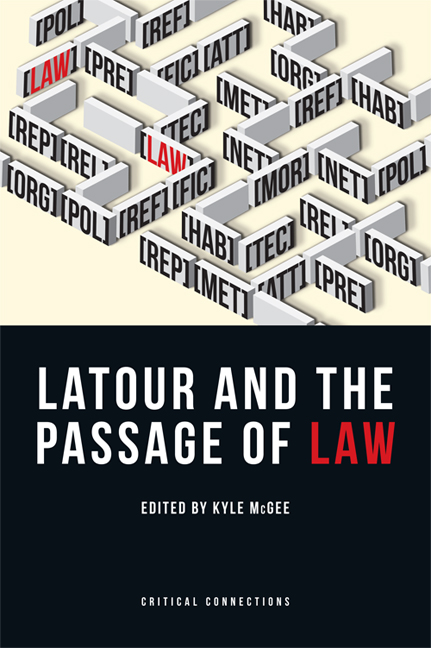Book contents
- Frontmatter
- Contents
- Introduction
- 1 From the Conseil d’État to Gaia: Bruno Latour on Law, Surfaces and Depth
- 2 Politics and Law as Latourian Modes of Existence
- 3 On Devices and Logics of Legal Sense: Toward Socio-technical Legal Analysis
- 4 ‘The Crown Wears Many Hats’: Canadian Aboriginal Law and the Black-boxing of Empire
- 5 Providing the Missing Link: Law after Latour's Passage
- 6 The Life and Deaths of a Dispute: An Inquiry into Matters of Law
- 7 Plasma! Notes on Bruno Latour's Metaphysics of Law
- 8 The Conditions of a Good Judgment: From Law to Internal Affairs Police Investigations
- 9 In The Name of the Law: Ventriloquism and Juridical Matters
- 10 Laboratory Life and the Economics of Science in Law
- 11 Bartleby, Barbarians and the Legality of Literature
- 12 The Strange Entanglement of Jurimorphs
- List of Contributors
- Index
7 - Plasma! Notes on Bruno Latour's Metaphysics of Law
Published online by Cambridge University Press: 05 September 2016
- Frontmatter
- Contents
- Introduction
- 1 From the Conseil d’État to Gaia: Bruno Latour on Law, Surfaces and Depth
- 2 Politics and Law as Latourian Modes of Existence
- 3 On Devices and Logics of Legal Sense: Toward Socio-technical Legal Analysis
- 4 ‘The Crown Wears Many Hats’: Canadian Aboriginal Law and the Black-boxing of Empire
- 5 Providing the Missing Link: Law after Latour's Passage
- 6 The Life and Deaths of a Dispute: An Inquiry into Matters of Law
- 7 Plasma! Notes on Bruno Latour's Metaphysics of Law
- 8 The Conditions of a Good Judgment: From Law to Internal Affairs Police Investigations
- 9 In The Name of the Law: Ventriloquism and Juridical Matters
- 10 Laboratory Life and the Economics of Science in Law
- 11 Bartleby, Barbarians and the Legality of Literature
- 12 The Strange Entanglement of Jurimorphs
- List of Contributors
- Index
Summary
The possibility of inclusion
On 5 February 2008, in the Graham Wallas Room of the London School of Economics’ Old Building, a small group of researchers gathered to listen to Graham Harman discuss the book he had devoted to the work of Bruno Latour – the latter himself being present. It was a meeting destined to occur: since 1999, when he published his first article on the French thinker, Harman had never ceased to attempt to articulate the seemingly antagonistic thoughts of his two favourite thinkers: Latour and Heidegger. When he wrote Prince of Networks, the monograph in which he explained his understanding of the work of Latour, the form taken by this articulation was finally complete, although it remained controversial – a form in which Latour was only able to half-recognise himself. Or so he told Harman, who heard it. The book that was eventually published from the manuscript discussed at the London School of Economics differed in many respects from its original version – yet, Harman persisted in maintaining the main thesis defended in it. According to this thesis, the thought of Latour was caught in a process of infinite regress, since its primary object was the network of relationships in which things have access to something like an essence or a being. For Harman, this was a paradox that he refused, nevertheless, to regard as a flaw or a weakness – a paradox that could be formulated as a question: what is a network, if not a thing whose being, if one was to follow Latour's argumentation, should be considered in terms of relations? Even if it was a thought centred on ontological tolerance, Latour's metaphysics stumbled against the fact that there were beings excluded from this tolerance – or rather beings that this tolerance included in a form other than the form of being. To this objection, Latour's response was easy: if networks did not belong to the realm of beings, it was because being could be said in multiple ways, and because that multiplicity included an ontological ‘class’, a ‘mode of existence’, which was precisely that of the network.
- Type
- Chapter
- Information
- Latour and the Passage of Law , pp. 197 - 208Publisher: Edinburgh University PressPrint publication year: 2015

